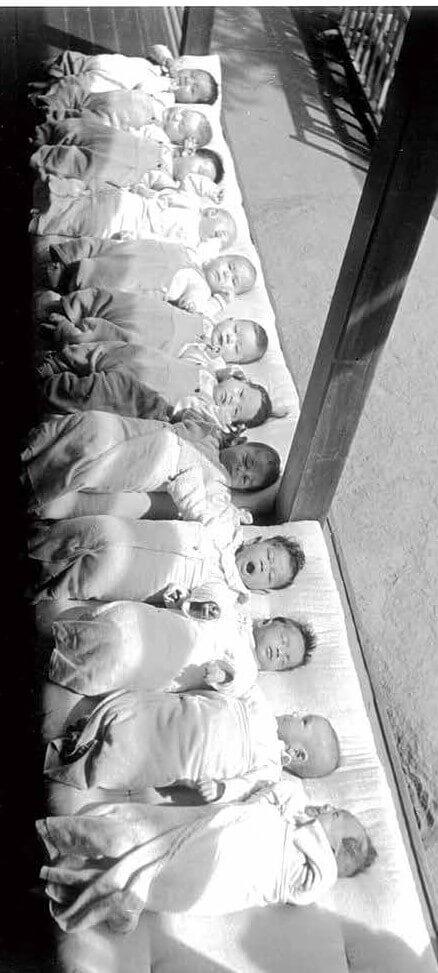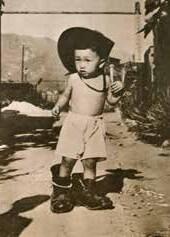Issue:
THE SONS AND DAUGHTERS OF AUSTRALIAN OCCUPATION FORCES TELL THEIR STORIES OF ABANDONMENT IN A RECENT BOOK


Not far from Yamate Station in the suburbs of Yokohama lies the small, neglected, almost anonymous Negishi Foreigners’ Cemetery. Unlike the more famous foreigners’ cemetery on the bluff overlooking this port city, Negishi was the last resting place of the poor, the sailors, the indigent and the diseased. Among the headstones, there is a monument to the unnamed dead also buried there including, it is said, more than 800 mixed race children abandoned during the postwar Occupation, whose fathers were foreign servicemen.
Between 1945 and 1952, the MacArthur whirlwind left little in Japanese society untouched. But nowhere did the Occupation have more of an impact than on relations between the sexes. Women obtained the vote, could stand for public office for the first time and gained legal equality within the family.
But it wasn’t the whole story.
In the shattered economy, fewer salaried jobs were available for women than before the war. Thousands of widows and homeless or displaced women and girls turned to the occupation servicemen as sources of food and shelter. The resulting mixed race children especially those of African American fathers sent shivers through society. A Japanese professor of medicine wrote in 1952: “The inundation of future konketsuji [literally ‘mixed blood child,’ and a word rarely used today because of its association with prejudice] could be more significant for Japan’s racial history than the atomic bomb.”
During my time as a correspondent in Japan in the 1980s and ’90s, I found the subject hard to penetrate: the konketsuji had either made themselves invisible or refused to discuss their experiences. In 2005, I tried again and, with the help of a social worker who had run a welfare program for the children, managed to get behind the veil of secrecy. The documentary I made for the Australian Broadcasting Corporation led to new encounters and a realization that much of the received wisdom on the subject was dead wrong. I decided to write a book.
The misconceptions were many, I found. When the Occupation ended in 1952, it was believed upwards of 200,000 children of mixed blood had been left behind in Japan. The true number was nearer 10,000.
The children were portrayed as “waifs.” In fact, only around five to 10 percent were ever placed in care. Most were raised by their mothers or relations and attended school alongside other Japanese.
Publications claimed many children were sent to Brazil as farmers. In fact, only a couple of dozen boys took that route. More than 2,000, however, were placed for adoption with families in the United States.
Although it was assumed the mothers were mainly prostitutes, many, in fact, had worked for the Occupation forces as waitresses, typists, cleaners, and so forth. Possibly no more than 10 percent were prostitutes, in the strict sense.
Commentators predicted the children would show low intelligence and a tendency to antisocial behavior. In fact, the IQ scores of those in family situations were on a par with the average Japanese, and delinquency was the result of social prejudice and socioeconomic disadvantage, not genetics.
My story began in 1946, when the British Commonwealth Occupation Force (BCOF), 40,000 strong, marched into the bomb scarred port city of Kure, near Hiroshima. The largest contingent was from Australia; due to the Korean War, troops from the country would still be there a full decade later.
Unlike the American military, the Australians were told to keep their dealings with the “defeated enemy” to a minimum, under a non-fraternization policy. But the Occupation was Kure’s biggest employer, and daily contacts in the workplace as well as at places of entertainment led to clandestine romances. Early on, in fact, food was so short that a soldier could buy female companionship for as little as a can of condensed milk or a packet of sugar.
If a soldier formed a de facto relationship and fathered a child, he had no way of protecting them once his deployment came to an end. It wasn’t until 1952 that a serviceman was granted permission to marry a Japanese. Even after the marriage ban was lifted, no Australian senior officer dared seek permission to take home a Japanese bride.
So it happened that scores of women, and the children they had conceived with their Australian lovers, were left behind.
It took years for the plight of the abandoned children to come to the attention of the Australian public. In 1956, Corporal George Budworth applied from Japan to the Immigration Department to bring in to Australia a mixed blood child he had already adopted. His application and a couple of others were the first to be considered by the department, and it realized it needed a policy.
It was decided that to allow “any considerable number” of these mixed race children into the country would be contrary to the White Australia policy.
An exception was made for Budworth and one or two others to bring their adopted children with them to Australia, but, in the future, any couple wishing to adopt would have to go to Japan and spend 6-9 months there looking after a child before it would be eligible for admission.
As an alternative to adoption, the Menzies Cabinet agreed in 1962 to make an annual grant to the welfare agency, International Social Service, which had opened an office in Kure to help the families. The money was offered on condition it was used to assist “all mixed bloods,” not just those with Australian fathers in this way the government could continue to deny direct responsibility. Canberra went on to contribute the equivalent of almost $1 million (at today’s values) over the next decade, a sum that was matched by private donations.
My contacts led to a number of stories told by those who were abandoned.

Toshie Fukuhara and her two children, fathered by an Army major, stayed behind in Kure when he left in 1956. Faithful, if irresolute, he sent cards on the children’s birthdays and a regular sum of money to Toshie for the housekeeping. Daughter Junko remembers the cakes her mother would buy as a special treat when the money arrived. “So, for me, ‘cake’ equals ‘father,’” she says, forcing a smile.
Private Joe Ritchie and Sachiko Tsutsumi were secretly married in 1949. Their son, George, was less a year old when his father departed with the 3rd Battalion Royal Australian Regiment for the Korean War, where he died in the first winter of the fighting.
With no means of support certainly no war widow’s pension George’s mother took off in search of work, leaving her infant son behind. He grew up among strangers, lonely and desperately poor. Despite the best efforts of the ISS social workers, he turned delinquent in his teenage years and quit school early.
As he explains, social prejudice against the children was so strong there seemed little point in trying to do better: “The [mixed race] children’s faces were the faces of those who, not so long ago, were dropping bombs. The faces, by themselves, provoked animosity. For those who had been educated to hate, I guess it was natural to feel hatred when they saw the miniatures of their enemy hanging around. . . . I understand this now, but at the time, I wondered why I was singled out for bullying.”
Some of the children excelled at sport or found jobs as models or performers because of their good looks. They could win respect that way. George’s good fortune was to marry young. Responsibility forced him to take control of his life especially after the birth of the first of his three sons.
Recently retired after 40 years of working on the Nagoya docks, and a grandfather several times over, he still feels bitter that Australia would not receive him as a child.
Kazumi Yoshida’s mother, Mitsuko, was working as a waitress at a BCOF sergeant’s mess when she met Kazumi’s father. He left before his daughter was born, in November 1947, and made no further contact.
Life was tough. At one point, when the rent money was overdue, and the future seemed bleak, young Kazumi found herself having to talk her mother out of committing suicide.
In 1965, Mitsuko accepted a marriage proposal from an Australian ex-serviceman, and the family packed up and left Japan. But Kazumi could never stop wondering about her natural father: what happened to him, and why he had not come looking for her.
Recently she fulfilled a lifelong dream by identifying him from Army records. Though he had passed away, she discovered that he was already married when he went to Japan, and that she had four half-siblings. DNA tests were done, and Kazumi felt overjoyed to be received into her new extended family.
The Kure Project wound up in 1977. Its greatest achievement was in education: around a third of its 130 children completed senior high, and one in eight obtained a university or college degree. (Among Occupationera children in Japan as a whole, only around 10 percent advanced beyond junior high school.)
Though better educational outcomes led to better jobs and better marriage prospects for the Kure Kids, in both respects they remained at a disadvantage in society. Many still carry the emotional scars of a troubled childhood and would not want their struggles underestimated. And yet, thankfully, the facile prediction often aired at the time of the Occupation that the boys would all finish as gangsters and the girls all prostitutes has proven to be well wide of the mark.
Walter Hamilton reported from Japan for 11 years for the Australian Broadcasting Corporation. His book, Children of the Occupation: Japan’s Untold Story, was published in 2012.

